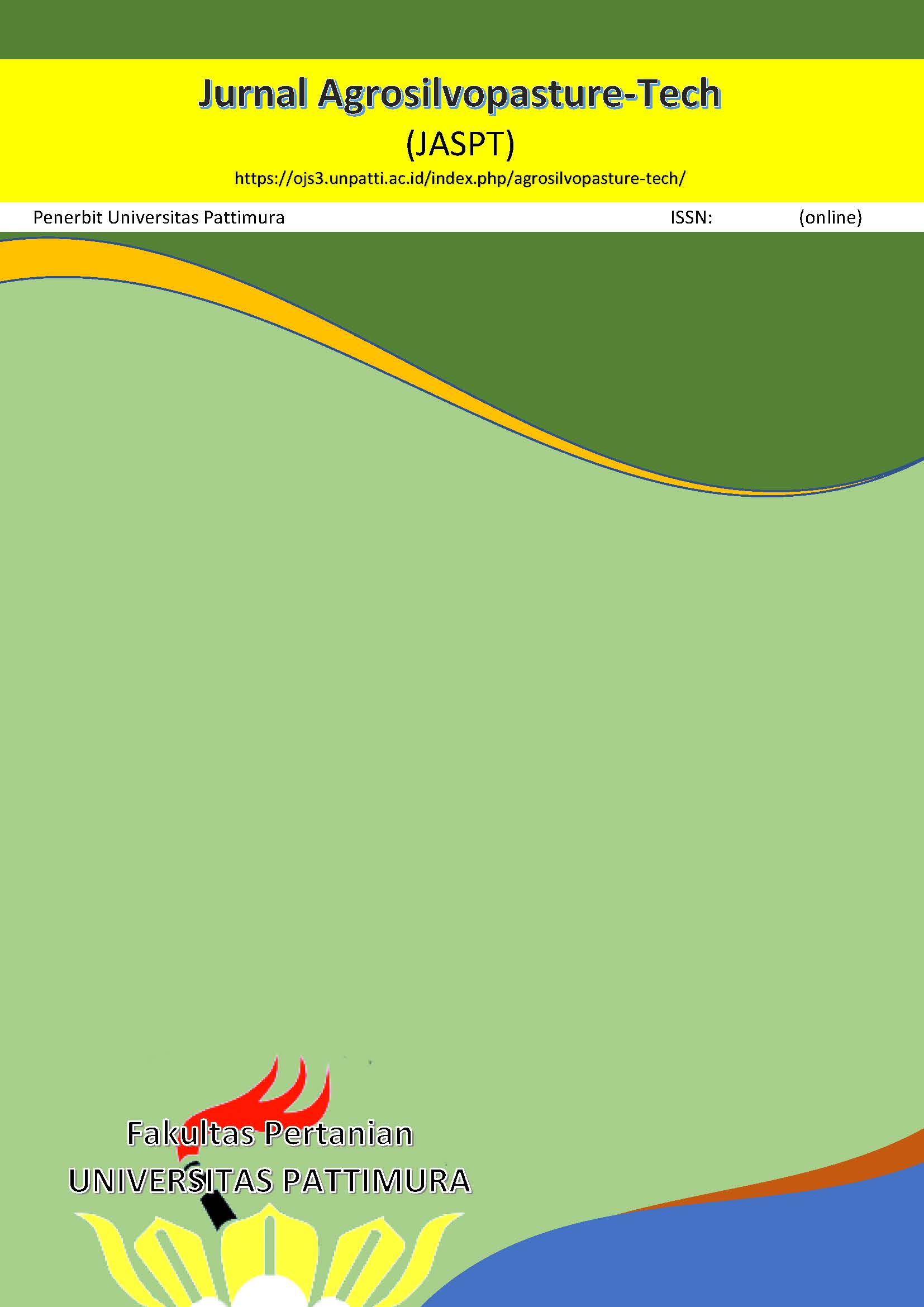Ketahanan Beberapa Galur Harapan Kacang Hijau Asal Kepulauan Tanimbar Terhadap Penyakit Busuk Akar Basah (Rhizoctonia Solani Kuhn)
Performance And Yield of Some Local Corn Accessions of Kisar Island, Maluku Barat Daya Regency
Abstract
Mung bean is a supplemental and alternative food source whose disease attacks often hamper cultivation. One of the main diseases that attacks mung beans is wet root rot caused by R. solani, which has a negative effect on growth and causes a decrease in crop yield. This research aimed to determine mung bean lines resistant to wet root rot disease and the level of resistance of the lines from the Tanimbar Islands to wet root rot disease. This research was carried out at the Disease Diagnosis Laboratory, Pattimura University, and took place from July to September 2023. It used descriptive analysis involving eight treatments in the form of 8 local mung bean genotypes from the Tanimbar Islands. The R. solani isolate used to test the resistance of mung bean genotypes was taken from samples of diseased plants (mustard), isolated on PDA media, and grown for seven days. The genotypes that were tested by inoculation at the seedling stage consisted of KC_3-8, KC_6-1, KC_8-2, KC_9-10, KC_23-6, KC_23-8, KC_23-9, and KC_26-4. In addition to the growth of young seedlings after inoculation, the parameters as indicators of mung bean resistance were the incubation period and disease severity in each genotype. Analyses of the incubation period, severity of wet root rot disease, and vegetative plant growth data consisting of sprout height, number of leaves, root length, and fresh and dry weight, were carried out descriptively. The results of this study indicate that three genotypes were moderately susceptible to R. solani, namely KC_6-1, KC_3-8, and KC_9-10; whereas the genotypes KC_26-4, KC_23-6, KC_25-8, KC_25-8, KC_28-9 were included in the susceptible category. The lowest root rot disease severity was found in genotypes KC_6-1, KC_3-8, and KC_9-10, while the other five genotypes were in the high category.
Downloads
References
Agrios, G.N. (2005). Plant Pathology. 5th ed. 2005. San Diego (US): Elsevier Academic Press
Ajayi-Oyetunda, O.O, & Bradley, C.A. 2018. Rhizoctonia solani: taxonomy, population biology and management of Rhizoctonia seedling disease of soybean. British Society for Plant Pathology, 67, 3–17. DOI: 10.1111/ppa.12733.
Balitkabi. (2008). Deskripsi varietas unggul kacang-kacangan dan umbi-umbian, Balai Penelitian Tanaman Kacang-kacangan dan Umbi-umbian, Malang.
Basandrai, A. K., Basandrai, D., & Sharma, B.K. 2016. Fungicidal management of web blight of urd bean caused by Rhizoctonia solani. Leg. Res. Int. J. 39, 1038–1042.
Bateman, D. F., & Basham, H. G. (1976). Degradation of Plant Cell Walls and Membranes by Microbial Enzymes. In: R. Heitefuss et al. (Eds.). Physiological Plant Pathology. Springer-Verlag Berlin, Heidelberg. https://doi.org/10.1007/978-3-642-66279-9_13.
Behiry, S., Soliman, S.A., Massoud, M.A., Abdelbary, M., Kordy, A.M., Abdelkhalek, A., & Heflish, A. (2023). Trichoderma pubescens elicit induced systemic resistance in tomato challenged by Rhizoctonia solani. Journal of Fungi, 9(2). https://doi.org/10.3390/jof9020167
Inayati, A., Sulistiyo, D.S., Yusnawan, E. & Hapsari, R.T. (2016). Evaluasi ketahanan plasma nutfah kacang hijau terhadap penyakit busuk akar Rhizoctonia. Dalam: Prosiding Seminar Hasil Penelitian Tanaman Aneka Kacang dan Umbi, 457.
Jia, Y., Correa-Victoria, F., McClung, A., Zhu, L., Liu, G., Wamishe, Y., Xie, J., Marchetti, M.A., Pinson, S.R.M., Rutger, J.N., & Correl, J.C. (2007). Rapid determination of rice cultivar responses to the sheath blight pathogen Rhizoctonia solani using micro-chamber screening method. Plant Disease, 91, 485−489.
Kassa, Y., Abie, A., Mamo, D., & Ayele, T. (2023). Exploring farmer perceptions and evaluating the performance of mung bean (Vigna radiata L.) varieties in Amhara region, Ethiopia. Heliyon, 8, 1-10.
Kementerian Pertanian, 2020. Produksi kacang hijau tahun 2019, Kementerian Pertanian, Jakarta.
Kumari, P., Meena, M., Gupta, P., Dubey, M. K., Nath, G., & Upadhyay, R.S. (2018). Plant growth promoting Rhizobacteria and their biopriming for growth promotion in mung bean (Vigna radiata (L.) R. Wilczek). Biocatalysis and Agricultural Biotechnology, 16. https://doi.org/10.1016/j.bcab.2018.07.030
Mohler, C.M., & Johnson, S.E. (2009). Crop Rotation on Organic Farms A Planning Manual. Sustainable Agriculture Research and Education (SARE) Plant and Life Sciences Publishing (PALS) Cooperative Extension NRAES 177 154p. Cornell University, Ithaca, New York.
Natawigena, H. (1993). Dasar-dasar Perlindungan Tanaman. Trigenda Karya. Bandung.
Priyatmojo, A. (2006). Tipe mating pada empat isolat Thanatephorus cucmeris (Anamorph: Rhizoctonia solani) anastomosis group (AG) I-1C. Jurnal Perlindungan Tanaman Indonesia, 2, 112.
Purnomo dan Hartono, (2005). Kacang Hijau (Green Beans). Penebar Swadaya, Jakarta
Purnomo, J., Yusnawan, E., Radjit, B.S., Trustinah, Wahyuningsih, S., Wasito, A., & Marwoto. (2013). Penelitian Aneka Kacang dan Umbian, Laporan Tahunan Balitkabi, Malang.
Reddy, P.P. (2016). High-Yielding and adapted varieties. In: Sustainable Intensification of Crop Production. Springer, Singapore. https://doi.org/10.1007/978-981-10-2702-4_9.
Semangun, H. (2000). Penyakit Tanaman Hortikultura di Indonesia. Gajah Mada University Press: Yogyakarta.
Sumartini, Uge, E., & Baliadi, Y. (2020). Penyakit Utama Pada Tanaman: Kedelai, Kacang Tanah dan Kacang Hijau: Balai Penelitian Tanaman Aneka Kacang dan Umbi, Malang.
Trustinah, Radjit, B.S., Prasetiaswati, N. & Harnowo, D. (2014). Adopsi varietas unggul kacang hijau di sentra produksi. Iptek Tanaman Pangan, 9(1), 24-38.
Umer, M., Mubeen, M., Shakeel, Q., Ali, S., Iftikhar, Y., Bajwa, R. T., Anwar, N., Rao, M.J., & He, Y. (2023). Mycoviruses: antagonistic potential, fungal pathogenesis, and their interaction with Rhizoctonia solani. Microorganisms, 11(10), 2515. https://doi.org/10.3390/microorganisms11102515.
Copyright (c) 2024 The Author(s)

This work is licensed under a Creative Commons Attribution-ShareAlike 4.0 International License.




.png)

